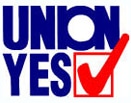 WASHINGTON – U.S. Secretary of Labor Thomas E. Perez issued the following statement on the department’s Bureau of Labor Statistics report released today on union membership in 2014:
WASHINGTON – U.S. Secretary of Labor Thomas E. Perez issued the following statement on the department’s Bureau of Labor Statistics report released today on union membership in 2014:
“Today’s report confirms what we’ve always known: that belonging to a union makes a powerful difference in people’s lives, providing greater economic security and helping them punch their ticket to the middle class.
“The 2014 BLS data show that among wage and salary workers, those in a union have median weekly earnings of $970, compared to $763 for those not in a union. That’s not pocket change – it amounts to greater than $10,000 a year more for union members. There is also a smaller gender pay gap for unionized workers – women who are in a union come closer to parity with their male counterparts than do non-union women. The report also finds that the union membership rate was 11.1 percent last year, 35.7 percent for public-sector workers.
“The economy is resurgent, with an unemployment rate well below 6 percent and job growth we haven’t experienced since the late 1990’s. The challenge we face now is creating shared prosperity, ensuring that our growing economy works for everyone. To do that, we need to turn up the volume on worker voice.
“There is a direct link throughout American history between the strength of the middle class and the vitality of the labor movement. It’s not a coincidence. When unions are strong, working families thrive, with wages and productivity rising in tandem. But when the percentage of people represented by unions is low, there is downward pressure on wages and the middle class takes it on the chin.
“President Obama said in the State of the Union that middle-class economics requires ‘laws that strengthen rather than weaken unions, and give workers a voice.’ That means protecting and strengthening collective bargaining rights, and it also means exploring new organizing strategies and other innovative approaches to empowering workers in a modern economy.
“Across the country at the grass-roots level, workers and their advocates are doing just that. Whether it’s auto workers emulating the German works council model, or the dynamic movement of fast-food workers seeking a raise, or efforts by taxi drivers and home health care workers to stand up for their rights, we are seeing more people seeking creative ways to make their voices heard.
“Doing so can and must be done in collaboration with employers. We reject the old false choice and zero-sum thinking – the kind that suggests either workers or their employers can thrive, but not both. Unions succeed not at the expense of business, but in partnership with business. Forward-looking employers recognize that they can give their workers a voice while giving their bottom line a boost.
“To maintain robust economic growth, to create more shared prosperity and a better life for millions of middle-class families, we need full-throated worker voice.”
 Union membership has its perks: higher wages, better healthcare, more job security. Now, a new study from the Center for American Progress, a left-leaning think tank, adds another benefit to that list: richer children, once they’re all grown up.
Union membership has its perks: higher wages, better healthcare, more job security. Now, a new study from the Center for American Progress, a left-leaning think tank, adds another benefit to that list: richer children, once they’re all grown up. WASHINGTON – U.S. Secretary of Labor Thomas E. Perez issued the following statement on the department’s Bureau of Labor Statistics report released today on union membership in 2014:
WASHINGTON – U.S. Secretary of Labor Thomas E. Perez issued the following statement on the department’s Bureau of Labor Statistics report released today on union membership in 2014: